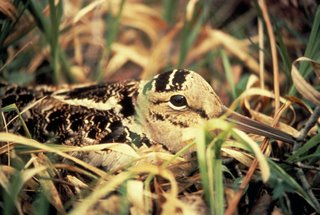Many bird species have already begun moving north. It may not be immediately apparent to the casual observer, but if you start to look closely you may see some species declining in numbers and others increasing compared to a few weeks ago. One distinctive species that is on the move right now is the American Woodcock.
The American Woodcock belongs to the order Charadriiformes, commonly known as shorebirds. Woodcocks can be easily separated from most other shorebirds by its long bill, short neck and legs, and plump body. The one other shorebird that has a similar shape is the Wilson's Snipe. Unlike snipe, which have white bellies that contrast sharply with heavily streaked breasts, woodcocks have buffy bellies and breasts without significant striping. Woodcocks walk with a bouncing gait as they probe the ground for earthworms.
Both woodcocks and snipe can be difficult to spot because of their cryptic feather patterns. You can walk right past one, or even run your binoculars right over one, without seeing it. If you are lucky, the bird will flush and give you a glimpse of itself. If you are really lucky, the bird will sit out in the open. My one sighting of a woodcock was highly unusual for such encounters. That particular woodcock did not seem to mind a dozen or so people looking at it intently with binoculars.
The best way to observe woodcocks is during their mating rituals. The show starts at dusk in open fields in spring and summer. Male woodcocks will first give a series of buzzy nasal peent calls and then fly high in the air, tracing a fluttering spiral down to the ground while twittering. The twittering sounds associated with this flight are a combination of chirping calls, given vocally, and fluttering sounds made by certain feathers on its wings.
Certain places are known as display grounds for woodcocks on a yearly basis. Near Washington, DC, the fields around Hughes Hollow and Sycamore Landing Road in Montgomery County, MD; and Huntley Meadows in Fairfax County, VA, have reputations as good places to observe the woodcock mating rituals. To find display grounds in your own area, consult local birding guides or email listserves.
See here for sounds and video of this species. This site (scroll down) also has recordings of a woodcock display.




